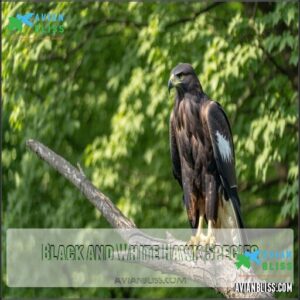This site is supported by our readers. We may earn a commission, at no cost to you, if you purchase through links.

These raptors feature distinctive plumage patterns that help you identify them in flight – look for the Zone-tailed’s Turkey Vulture-like silhouette or the Common Black Hawk’s broad white tail band.
Each species occupies specific habitats, from southwestern canyons to eastern woodlands.
Their hunting strategies are equally varied, with some soaring high while others prefer ambush tactics from perches.
The secrets to distinguishing these look-alike predators often lie in subtle wing and tail shapes.
Table Of Contents
- Key Takeaways
- Black and White Hawk Species
- Hawk Migration Patterns Explained
- Identifying Black and White Hawks in Flight
- Common Mistakes in Hawk Identification
- Habitat and Distribution of Black and White Hawks
- Black and White Hawk Diet and Hunting Habits
- Black and White Hawk Conservation Status
- Best Photos for Black and White Hawk Identification
- Identifying Black and White Hawks in Texas
- Unique Features of Black and White Hawks
- Frequently Asked Questions (FAQs)
- What is a black and white hawk eagle?
- What does a Black Hawk look like?
- Are there Black Hawks in California?
- Where do black & white hawk eagles live?
- Where do Black Hawks Live?
- What does a Harris hawk look like?
- What is the difference between a Black Hawk and a harrier hawk?
- Where does the black & white hawk eagle live?
- What hawks are black-and-white?
- Where do black-and-white hawk eagles live?
- Conclusion
Key Takeaways
- You’ll recognize North American black and white hawks by their distinctive features—look for the Zone-tailed Hawk’s vulture-like silhouette, the Common Black Hawk’s bold white tail band, and the dark morphs of Rough-legged and Red-tailed Hawks.
- When identifying these hawks in flight, focus on their wing shapes, tail patterns, and flight behavior—Zone-tailed Hawks mimic vultures with a rocking flight style, while the Common Black Hawk displays steady, slow flight with broad wings.
- You’ll find these raptors in specific habitats—Zone-tailed Hawks prefer southwestern canyons near water sources, Common Black Hawks inhabit riparian zones, and Harris’s Hawks thrive in desert environments where they hunt cooperatively.
- You can support black and white hawk conservation by joining citizen science programs that track populations, reducing pesticide use to maintain healthy prey populations, and practicing responsible birding by maintaining a respectful distance from nesting sites.
Black and White Hawk Species
You’ll encounter several striking black and white hawk species across North America.
These include the Zone-tailed Hawk with its vulture-like appearance, the Common Black Hawk with its bold white tail band, and dark morphs of the Rough-legged and Swainson’s Hawks.
Each species displays unique wing patterns, flight behaviors, and habitat preferences that you can learn to recognize with practice.
Zone-tailed Hawk Characteristics
The Zone-tailed Hawk masterfully employs vulture mimicry in both appearance and behavior, fooling prey with its distinctive flight style.
This medium-sized raptor features striking black plumage with silver-barred flight feathers and a white-banded tail.
- Yellow legs, feet, and cere provide stark contrast to its dark coloration
- Soars with distinctive dihedral wing position, rocking side-to-side like turkey vultures
- Prefers arid adaptations in southwestern canyons, mesas, and foothills near streams
Look for its plumage variation between adults and immatures when practicing hawk identification.
Common Black Hawk Identification
The Common Black Hawk stands out among black and white hawks with its distinctive soot-black plumage and bold white tail band.
When identifying this species, focus on its broad wings with rounded tips and steady, slow flight pattern.
Listen for their distinctive vocalizations near riparian habitats.
Range overlap with Zone-tailed Hawks requires careful observation of plumage variations.
Rough-legged Hawk Dark Morph Description
When out in the field, you’ll spot the Roughlegged Hawk dark morph by its distinctive plumage patterns among black and white hawk species.
Regional differences affect dark morph genetics substantially.
Here’s what to look for:
- Chocolate-brown body contrasts with silvery underwing flight feathers
- Two-toned underwing appearance creates unmistakable identification pattern
- Finely banded tail lacks the white base of light morphs
- Dark patches at wing wrists visible during soaring
- Black belly patch distinguishes this raptor from other birds of prey
Master these markers for confident identification.
Swainson’s Hawk Dark Morph Characteristics
Moving from the Rough-legged Hawk, let’s examine another striking raptor variant.
Dark morph Swainson’s Hawks display distinctive features that set them apart from typical buteo species. You’ll recognize these rare birds by their entirely dark brown bodies contrasted with white patches under the tail.
| Feature | Characteristic |
|---|---|
| Body Color | Dark brown |
| Underwing | Paler coverts, darker flight feathers |
| Wing Shape | Long with pointed tips |
| Distribution | 1-10% of population (up to 35% in northern California) |
| Diet | Rodents, insects, small birds, reptiles |
Their two-toned underwing pattern creates a striking silhouette against the sky, showcasing their unique appearance as rare birds with a notable dark brown color, making them a fascinating sight to observe in their natural habitat.
Harlan’s Red-tailed Hawk Identification
The enigmatic Harlan’s Red-tailed Hawk displays a patchwork of plumage variations that challenge even experienced birders.
You’ll recognize this striking raptor subspecies by:
- Its variable dark morph featuring black, white, and gray mottling
- A distinctly different tail pattern from typical Red-tailed Hawks
- Regional differences in appearance across its range
- Age identification markers that shift with molting patterns
- Subtle hybridization concerns requiring careful observation
When in doubt, focus on the hawk’s distinctive silhouette and flight style.
Hawk Migration Patterns Explained
You’ll witness thousands of black and white hawks soaring along ancient skyways each year as they travel between breeding grounds and wintering areas, using thermal updrafts to conserve energy.
These remarkable migrations follow predictable seasonal patterns, with species like the Zone-tailed Hawk heading south in September and the Common Black Hawk returning northward by early April.
Creating spectacular viewing opportunities at hotspots such as Hawk Mountain and Cape May is a key aspect of these migrations, making them a thrilling experience for observers.
Timing of Hawk Migration
After learning about various black and white hawk species, you’ll want to understand when to spot them during their impressive journeys across continents.
Hawk migration follows predictable patterns, though timing varies based on specific migration triggers. These magnificent birds respond to changing daylight hours, weather influence, and food availability when planning their seasonal movements.
| Species | Spring Migration | Fall Migration | Weather Sensitivity |
|---|---|---|---|
| Black-and-white Hawk-Eagle | March-April | September-November | High |
| Zone-tailed Hawk | Early April | Mid-September | Moderate |
| Common Black Hawk | Late March | Early October | High |
| Northern Harrier | February-April | August-November | Low |
Climate change has caused earlier migrations in some species, shifting traditional hawk migration routes. You’ll find the most activity during peak migration periods when thermal currents provide perfect lifting conditions.
A hawk migration map can help you track these birds as they follow coastlines and ridges, creating breathtaking opportunities to witness nature’s aerial spectacle.
How to Identify Migrating Black and White Hawks
Three key features help you identify migrating black and white hawks with confidence. During migration, focus on distinctive silhouettes against the sky as raptors ride thermal currents.
Zone-tailed Hawks often mimic Turkey Vultures’ flight patterns, while Swainson’s dark morphs display characteristic dihedral wing positions. Common Black Hawks reveal their bold white tail bands during soaring.
- Watch for plumage changes that signal migration readiness – many species molt before their journey, revealing fresh feathers with sharper contrast.
Regional variations matter too! Northern harriers glide low over grasslands, while rough-legged hawks maintain a distinctive hover when hunting during migration stopovers.
Best Places to Spot Migrating Hawks
Where can you position yourself to witness nature’s greatest aerial spectacle? Discovering migration hotspots is key to successful hawk watching experiences. Weather impacts timing substantially, so plan accordingly.
For ideal viewing of black and white hawk species, visit these hawk watching hotspots:
- Hawk Ridge, Duluth: Tens of thousands of Broad-winged Hawks fly over in September, with birds forced closer to the ridge edge by updrafts between 9am-3pm.
- Cape May Point, NJ: The "raptor capital of America" features observation platforms and hosts a festival in late October.
- Detroit River Hawk Watch: Peak migration occurs mid-September with thousands of hawks visible from the migration watch platform.
Don’t forget viewing equipment like binoculars and follow ethical birding practices. Selecting the right binoculars for hawk watching can greatly enhance your viewing experience. Bird migration routes often follow coastlines and ridgelines where updrafts create efficient travel corridors.
Identifying Black and White Hawks in Flight
You’ll spot black and white hawks in flight by observing their distinctive wing shapes, tail patterns, and unique silhouettes against the sky, with species like the Zone-tailed Hawk mimicking vultures while the Common Black Hawk displays its bold white tail band.
When you focus on wing position and flight behavior, you’ll notice that soaring hawks hold their wings in a slight V-shape while hunting hawks frequently alternate between flapping and gliding.
Wing Shape and Size
After learning about migration patterns, you’ll want to focus on wing structure when identifying hawks in flight.
Wing shape and size are powerful indicators of a hawk’s flight style and hunting ability.
- Broad wings with "fingers" at tips indicate soaring specialists like Zone-tailed Hawks
- Pointed, narrow wings belong to speedy, agile hunters
- Rounded, short wings enable forest species to maneuver through dense vegetation
- Wingspan correlates directly with hunting styles—larger spans for open-country soaring
- Wing posture during flight reveals species-specific identification markers
The Black-and-white Hawk-Eagle displays impressive long, narrow wings that maximize flight agility while maintaining efficient soaring ability.
Species variation in wing morphology directly connects to their ecological niche.
You’ll notice that wings aren’t just for flying—they’re specialized instruments revealing each hawk’s lifestyle, hunting approach, and even their camouflage implications against the sky.
You can also observe their distinctive flight patterns for further identification.
Plumage Patterns and Coloration
While wing shape reveals flight capability, plumage patterns provide the definitive signature for black and white hawk identification.
Each species displays distinctive coloration that serves dual purposes: camouflage strategies and species differentiation.
The table summarizes key visual markers:
You’ll notice age variation in juveniles, which often show mottled patterns versus adult plumage.
Light morph varieties create additional identification challenges.
Some hawks exhibit melanism/leucism—unusually dark or light coloration—making identification trickier.
Regional differences also exist, with bird coloration varying subtly across habitats.
These avian species use their distinctive markings not just for identification but as effective hunting tools.
They utilize distinctive coloration to adapt to their environments, making them highly efficient predators.
Beak Shape and Eyes
Through the lens of beak shape and eyes, you’ll discover key identification secrets of black and white hawks.
The beak morphology of these birds of prey reveals their hunting adaptations—powerful, hooked designs perfectly evolved for tearing flesh.
- Eye coloration varies dramatically between species, with immature birds often showing lighter iris colors
- Beak shape differences help distinguish similar species like the Black-and-white Hawk-Eagle
- Sensory perception capabilities allow hawks to spot tiny prey movements from hundreds of feet up
- Species differentiation often relies on subtleties in facial structure and eye position
Tail Shape and Flight Patterns
Every black and white hawk species exhibits unique tail shapes that directly influence their flight patterns. When you’re tracking the Zone-tailed Hawk or Blackandwhite Hawkeagle, watch how they manipulate their tails for precise control during soaring or hunting.
Fan-shaped tails provide excellent maneuverability, while longer tails enable sharper turns during pursuit. You’ll notice distinct differences in soaring techniques—some glide with minimal tail movement, while others constantly adjust for stability.
Kite-like flight behavior often indicates specific species, particularly among hawks that hover before striking. Master these tail observations, and you’ll dramatically improve your species identification skills.
Common Mistakes in Hawk Identification
You’ll often mistake black and white hawks for similar species when you misjudge their size from a distance or rely too heavily on field guide illustrations rather than observing actual flight patterns.
Even experienced birders confuse Zone-tailed Hawks with Turkey Vultures or mistake dark morph Rough-legged Hawks for Common Black Hawks, especially when lighting conditions alter apparent plumage contrast.
Misjudging Size and Distance
A powerful pair of binoculars won’t solve one of birding’s most common perception challenges: misjudging size and distance when identifying black and white hawks. Even experienced birders struggle with visual illusions created by environmental factors and relative size comparisons.
When judging flight patterns and species identification, remember these key points:
- Distance dramatically distorts your perception of wingspan and bird weight
- Lighting conditions can make Blackandwhite Hawkeagle features disappear entirely
- Background elements create false size impressions that trick your brain
- Weather conditions alter your depth perception unexpectedly
Use the table provided as a reference guide for black and white hawk identification. By focusing on wing shape against known markers, you’ll overcome these common perception hurdles, and improve your skills in species identification.
Confusing Similar Species
While judging size correctly proves challenging, distinguishing between similar black and white hawk species can be equally perplexing.
The field poses numerous identification pitfalls where plumage variations often trick even experienced birders. You’ll find several hawk species that closely resemble each other, particularly when lighting influences your view. Regional differences in populations further complicate identification, as does the occasional hybridization case.
When confronting similar species, focus on:
- Wing pattern details – Zone-tailed Hawks display distinctive light patches while Common Black Hawks show more uniform coloration
- Tail band width – Black-and-white Hawk-Eagle sports a broader white band than similar species
- Head-to-body proportions – Juvenile vs. adult differences are particularly noticeable in head size relative to body mass
Remember that birds of prey often appear different depending on angle and distance. Patience and careful observation will transform frustrating misidentifications into confident species identification moments.
Relying Too Much on Field Guides
A birder’s obsession with field guides often hampers real hawk identification skills.
While bird field guides provide excellent illustrations, they can’t capture the dynamic nature of black and white hawks in their natural settings.
Ignoring habitat and behavior clues can also lead to misidentification.
Beyond illustrations, you’ll develop sharper bird identification skills by observing how hawks interact with habitat clues and listening for their distinct vocalizations.
Experience trumps memorization when distinguishing a Zone-tailed’s vulture-like soaring from a Common Black Hawk’s fishing behavior.
Your bird identification resources should include both guides and field time, as nothing replaces witnessing these magnificent raptors firsthand.
Habitat and Distribution of Black and White Hawks
You’ll find black and white hawks distributed across distinct ecological zones, from the Zone-tailed Hawk’s rocky canyons near water sources to the Common Black Hawk’s riparian habitats along streams and wetlands.
The Black-and-white Hawk-Eagle prefers tropical forests from Mexico to Argentina, while Harris’s Hawks thrive in desert environments where they build nests in tall cacti and hunt cooperatively across their range, showcasing their ability to adapt to different environments, such as desert environments.
Zone-tailed Hawk Breeding Grounds
The landscape reveals Zone-tailed Hawks establishing nesting habitat in southwestern North America’s highest perches.
This species shows strong breeding site fidelity, arriving in late March to construct stick nests in tall tree crotches or on cliffs.
Their preferred breeding territories include:
- Ponderosa pine stands at 5800-6450 ft elevations
- Dense oak-juniper habitat around 6600 ft
- Riparian zones with cottonwoods for parental care activities
- North-facing slopes offering thermal advantages during chick development
- Remote areas averaging 3.6km between active nests
Monogamous pairs perform acrobatic courtship displays before cooperatively building nests lined with fresh moss, leaves, and pine needles—creating ideal spaces for regional variations in this subspecies’ reproductive cycle.
They engage in cooperative building of these nests, which is a key aspect of their breeding behavior.
The combination of these factors contributes to the unique characteristics of the Zone-tailed Hawks’ nesting habits.
Common Black Hawk Habitat and Range
You’ll find Common Black Hawks patrolling riparian zones throughout their range from Arizona to South America, where water and land create perfect hunting grounds.
Like avian ninjas, these hawks need at least 70% canopy cover in lowland tropical forests to thrive.
The Common Black Hawk, scientifically known as Buteogallus anthracinus, faces habitat degradation as its primary conservation concern.
Range by Region & Key Features:
| Region | Habitat Type | Prey Focus | Conservation Status |
|---|---|---|---|
| Arizona | Desert Streams | Fish/Amphibians | Threatened locally |
| Central America | Riparian Areas | Crabs/Reptiles | Stable |
| South America | Forest Rivers | Mixed diet | Least Concern |
With habitat loss and climate change threatening these Neotropical birds of prey, scientists track their nesting ecology to understand how prey abundance affects population stability across their territory.
Harris’s Hawk Nesting Sites and Migration Routes
While Common Black Hawks seek water-rich environments, Harris’s Hawks have mastered survival in desert landscapes.
These resourceful birds construct their homes 15 to 30 feet above ground, with nearly 90% choosing dominant lookout spots that give them strategic hunting advantages.
Harris’s Hawk nesting sites reflect their unique lifestyle:
- Prime Real Estate: Desert-adapted cacti, sturdy mesquite trees, and protected cliff ledges
- Smart Materials: Local sticks, grasses, and bark assembled into surprisingly durable nests
- Family Affair: Multiple adults share parenting duties – a rare case of cooperative breeding
- Neighborhood Watch: Offspring often remain nearby, helping to raise younger siblings
- Moving Day: Unlike typical hawk migration patterns, they simply relocate to nearby food-rich areas
These savvy birds demonstrate that sometimes success isn’t about long-distance migration but mastering your environment. Their minimal movement of 15-20 miles showcases how habitat selection trumps seasonal journeys.
Black and White Hawk Diet and Hunting Habits
You’ll discover these incredible raptors have adapted remarkable hunting techniques to catch their preferred prey, from fish and amphibians to small mammals and birds.
Each black and white hawk species employs specialized strategies that make them successful predators, whether it’s the Zone-tailed Hawk’s clever vulture mimicry or the Common Black Hawk’s patient perch-and-plunge method for nabbing aquatic prey.
Prey Preferences and Hunting Strategies
Black and white hawks exhibit remarkable hunting techniques that showcase their predatory prowess across diverse landscapes.
You’ll discover these raptors adapt their hunting behavior based on available prey and terrain, making them versatile killers in the wild.
These birds of prey have perfected both aerial strikes and stealthy ground approaches, revealing fascinating hunting preferences:
- Zone-tailed hawks deceive prey by copying vulture flight patterns before striking
- Harris’s hawks demonstrate impressive cooperative hunting to conquer larger targets
- Common Black hawks patrol wetlands, snatching fish and frogs from shallow waters
- Rough-legged hawks showcase exceptional aerial control, hovering before plunging onto rodents
Their seasonal diet shifts with prey availability, targeting everything from insects to small mammals. Each species has evolved specialized hunting techniques suited to their hunting habitat, proving there’s no single formula for survival.
Zone-tailed Hawk Hunting Techniques
When you’re scanning the sky, you’ll notice Zone-tailed Hawks using vulture mimicry to perfect their sneak attacks.
They’ve mastered thermal soaring alongside Turkey Vultures, pretending to be harmless scavengers while actually planning precise hunting behavior.
This Zonetailed Hawk strategy lets them approach prey selection targets—like small mammals and birds—without raising alarm.
Their strike accuracy is remarkable. With talons ready, they’ll break from the vulture group, dropping suddenly with deadly speed.
Unlike cooperative hunting species, Zone-tailed Hawks hunt solo, but they’ve perfected social behavior by expertly fooling their prey into staying exposed. It’s nature’s stealth fighter at work.
Common Black Hawk Diet and Foraging Habits
You’ll discover Common Black Hawks (Buteogallus anthracinus) are master fishers who thrive along waterways where their powerful talons help secure meals.
Their specialized hawk diet relies on precise hunting techniques adapted perfectly for their riparian prey.
These birds primarily target:
- Fish they snatch with lightning-quick reflexes from shallow waters
- Frogs and salamanders they spot hiding in muddy banks
- Small reptiles basking on waterside rocks and logs
Unlike the Black-and-white Hawk-Eagle’s aerial tactics, Common Black Hawks perch low over streams, demonstrating incredible patience before striking.
Their remarkable amphibian consumption peaks during wet seasons when prey emerges abundantly, showcasing nature’s perfect timing.
Black and White Hawk Conservation Status
You’ll find most black and white hawk species currently classified as "Least Concern" on conservation lists, though their populations face ongoing threats from habitat fragmentation and human activity.
Conservation organizations actively monitor these elegant raptors through targeted research projects, with citizen science opportunities allowing you to contribute valuable data while enjoying these magnificent birds in their natural habitats, specifically in their natural habitats.
Threats to Hawk Populations
Why are these magnificent black and white hawks disappearing from our skies? Despite their aerial prowess, hawks face mounting challenges to survival.
Habitat loss ranks as the primary threat, with urban sprawl encroaching on essential nesting territories of species like ferruginous hawks. When wildfires repeatedly scorch the same areas, recovery becomes impossible.
Human-caused mortality takes a heavy toll too. Hawks frequently collide with cars, buildings, and wind turbines, while electrocution risks on powerlines claim numerous lives annually. Lead poisoning from rodenticides fatally affects city-dwelling hawks.
Climate change exacerbates these problems, with spring heat waves endangering nestlings and altering prey availability. Environmental contaminants continue to threaten hawk populations—pesticides like DDT historically caused eggshell thinning, and modern chemicals still contribute to hawk population decline. Their hunting specializations are affected by prey availability, impacting their survival rates.
Conservation Efforts and Organizations
While habitat loss threatens these majestic hunters, several organizations have stepped up to protect black and white hawk species across the Americas.
The Peregrine Fund works tirelessly on habitat protection initiatives, while the Mexican Harpy Eagle Initiative develops specific conservation strategies for the Black-and-White Hawk-Eagle.
Conservation efforts typically include:
- Population monitoring through satellite tracking and field research
- Community-based wildlife protection programs that train locals in ecotourism
- Preservation of communal lands that serve as critical migration corridors
Bird conservation organizations like Natura and Ecosistemas Mexicanos partner with government agencies to grant special protection status to threatened hawk species. Your support of these hawk conservation efforts through citizen science participation or funding conservation helps guarantee these aerial predators continue to patrol our skies for generations to come.
Ways to Support Black and White Hawk Conservation
Building on our understanding of conservation organizations, you can take tangible steps to protect black and white hawks.
You’ll make a real difference by joining citizen science programs that track hawk populations.
Support organizations fighting deforestation through donations or volunteer work.
The black-and-white hawk-eagle particularly needs your help.
Practice responsible birding by maintaining distance from nests.
Every small effort adds up—whether installing nest platforms or simply spreading awareness about wildlife protection, you’re helping these majestic birds thrive.
By following these steps, you contribute to the conservation of these species and ensure their habitats remain secure, which is crucial for their survival.
Best Photos for Black and White Hawk Identification
You’ll need clear, well-composed photographs that highlight the distinctive wing patterns, tail bands, and body coloration to accurately identify black and white hawk species in the field.
Proper lighting conditions reveal subtle plumage details, while photographs capturing hawks both perched and in flight provide complementary views that facilitate confident identification, especially when observing the subtle plumage details.
Examples of High-Quality Photos
While conservation efforts focus on protecting these magnificent birds, photographers play a vital role in documenting their beauty.
High-quality hawk photos serve as both identification tools and artistic expressions.
The most compelling black and white hawk images showcase:
- Soft morning or evening lighting that reveals intricate feather details and reduces harsh shadows
- Clean composition techniques that eliminate distracting elements and center the subject
- Tack-sharp focus on the eyes, bringing the hawk’s intensity to life
- Balanced background clarity that provides context without overwhelming the subject
- Natural postures that display characteristic behaviors and wing positions
Professional wildlife photographers often recommend shooting in RAW format, which preserves details in both dark plumage and bright sky areas—essential for hawk photography where contrast can be challenging, and capturing the hawk’s intensity is crucial for a compelling image, highlighting the importance of high-quality photos and conservation efforts.
Tips for Taking Good Photos of Hawks
Capturing stunning hawk photos requires five essential elements for success. Set your camera to at least 1/1000s shutter speed to freeze those powerful wingbeats in flight.
| Equipment Choices | Lighting Techniques |
|---|---|
| 300mm+ telephoto lens | Early morning golden hour |
| Sturdy tripod | Avoid harsh midday sun |
| Fast memory cards | Position with sun behind you |
| Camera with good autofocus | Use fill flash for shadows |
| Weather-sealed body | Cloudy days for even exposure |
Position yourself where hawk behavior suggests appearances—migration corridors, open fields with perching spots, or near nesting sites. For specialized equipment, consider a hawk photography lens.
Dress in earth tones and remain still; wildlife photography rewards patience. Zone-tailed and Black hawks often follow predictable patterns when hunting, making ethical observation possible without disturbing their natural activities. This approach allows for stunning photos and a deeper understanding of these birds.
Importance of Lighting and Composition
Now that you’ve mastered the basics of hawk photography, let’s focus on how lighting and composition transform ordinary shots into stunning identification images.
The right light makes all the difference when photographing black and white hawks. During Golden Hour, the soft illumination reveals intricate feather patterns while reducing harsh shadows. Backlighting Hawks creates dramatic silhouettes that highlight distinctive wing shapes essential for identification. To enhance your shots, consider specialized hawk lighting.
Follow these composition techniques for high-quality photos:
- Position yourself with the sun at your back for maximum detail in dark plumage
- Use the rule of thirds to place your subject where the eye naturally focuses
- Create Subject Isolation by shooting with a shallow depth of field
- Include Environmental Context to show natural habitat preferences
- Frame shots to emphasize diagnostic features like tail bands or wing patterns
The Black-and-white Hawk-Eagle’s striking contrast demands proper exposure – underexposed images lose detail in dark areas while overexposure washes out distinctive markings.
Identifying Black and White Hawks in Texas
You’ll find Texas offers excellent viewing opportunities for Zone-tailed Hawks and Common Black Hawks along the Rio Grande Valley and Edwards Plateau during spring migration.
When scanning the skies, watch for the Zone-tailed’s vulture-like soaring pattern and the Common Black Hawk’s distinctive white tail band against its dark plumage.
Red-tailed Hawk and Red-shouldered Hawk Sightings
Spotting Red-tailed and Red-shouldered Hawks in Texas is a treat for bird enthusiasts.
These North American birds showcase striking features—Red-tailed Hawks flaunt dark plumage with bold white tail bands, while Red-shouldered Hawks boast reddish underparts and black-and-white wing patterns.
Found in wooded areas, canyons, and desert edges, they’re masters of precision hunting.
Keep your bird identification guide handy, as their habitat overlap and regional variations can pose ID challenges during their seasonal abundance.
Northern Harrier and Cooper’s Hawk Migration Patterns
While Red-tailed and Red-shouldered Hawks often stay put, Northern Harriers and Cooper’s Hawks showcase fascinating migratory patterns through Texas.
Follow their impressive journeys:
- Northern Harriers sweep across marshlands and prairies, males arriving first at winter habitats
- Cooper’s Hawks navigate woodland corridors, flying lower than many North American hawks
- Both respond to migration triggers like shortening daylight and dropping temperatures
- Peak movement occurs mid-September through October
- Migration threats include habitat loss and extreme weather disrupting traditional paths
These routes follow established migration routes and flyways.
Other Black and White Hawk Species in Texas
Beyond the Northern Harrier and Cooper’s Hawk, Texas hosts several other remarkable black and white raptors that deserve your attention.
The White-tailed Hawk commands the southern Texas skies, while the Harris’s Hawk—with its dark plumage and rust-colored shoulders—hunts in family groups across central and east Texas.
When exploring Texas habitats, watch for:
- Zone-tailed Hawks with their vulture-like appearance and distinctive tail bands
- Common Black Hawks near water sources, hunting fish and amphibians
- White-tailed Hawks flourishing in coastal refuges like Laguna Atascosa
Texas’s bird species face increasing habitat loss, making citizen science participation essential for hawk conservation needs.
Unique Features of Black and White Hawks
You’ll notice black and white hawks exhibit distinctive features from their wing shapes that indicate soaring ability to their specialized beaks adapted for specific hunting strategies.
Their plumage patterns provide both critical camouflage in their preferred habitats and serve as key identification markers when you’re observing these magnificent raptors in the field.
Distinctive Plumage Patterns
The artistry of distinctive plumage patterns makes black and white hawks immediately recognizable in flight.
You’ll find their contrasting colors aren’t merely aesthetic—they serve essential camouflage functions and aid in species recognition.
The Black-and-white Hawk-Eagle (Spizaetus melanoleucus) displays striking monochromatic plumage with a pure white underside contrasted against jet-black upperparts.
Notable plumage variations exist between species:
Age-related changes are significant—juveniles often show different markings than adults.
Sexual dimorphism is subtle in most species, with females typically larger but similarly colored.
When observing these birds of prey, pay attention to distinctive features like the pattern on tail feathers, which often provides the most reliable identification clue.
Behavioral Characteristics
Beneath the striking plumage of black and white hawks lies a complex array of behavioral characteristics worth studying.
You’ll notice these raptors demonstrate remarkable adaptability across various contexts.
- Hunting strategies: Zone-tailed Hawks mimic turkey vultures’ flight patterns, deceiving prey animals that would otherwise flee from obvious predators.
- Social behavior: Unlike most solitary raptors, Harris’s Hawks hunt cooperatively in family groups, increasing success rates when pursuing agile prey.
- Communication methods: Each species uses distinctive vocalizations and physical displays to establish territory and attract mates.
- Territoriality: Black-and-white Hawk-Eagles fiercely defend their hunting grounds with impressive aerial demonstrations.
- Mating rituals: During mating season, pairs perform synchronized flight displays, showcasing mutual compatibility through graceful, coordinated movements.
These displays are similar to the courtship and mating rituals seen in other bird species.
Understanding these behavioral patterns enhances your ability to identify and appreciate these magnificent birds.
Habitat Preferences
Black and white hawks select habitat landscapes that perfectly match their unique hunting styles and nesting requirements.
You’ll notice these impressive raptors have developed specialized preferences that maximize their survival across diverse environments:
- Zone-tailed Hawks prefer arid habitats with rocky canyons near water sources, nesting in tall trees where they can survey vast desert regions
- Common Black Hawk populations concentrate along riparian zones, thriving in gallery forests and savanna habitats where water meets vegetation
- Black-and-white Hawk-Eagles inhabit tropical forests at varying elevation preferences, often hunting near forest edges and clearings
When observing hawk habitat selection, you’ll find these birds are incredibly particular about their surroundings. They’ll establish territories in locations that provide both suitable nesting locations and abundant prey, with some species requiring specific vegetation types that align with their evolutionary adaptations.
They’ll choose areas that offer the perfect balance of nesting requirements and prey availability, making them highly efficient hunters in their chosen environments.
Frequently Asked Questions (FAQs)
What is a black and white hawk eagle?
Just when you’re exploring tropical forests, you’ll spot the Black-and-white Hawk-Eagle soaring above. This powerful raptor features striking black and white plumage and inhabits lowland forests from Mexico to Argentina.
What does a Black Hawk look like?
A Common Black Hawk sports deep black plumage with a bold white tail band.
Its broad wings and short tail make it unmistakable.
You’ll often spot it near water, hunting fish, amphibians, or reptiles.
Are there Black Hawks in California?
You’ll find Common Black Hawks are rare visitors to California.
Instead, you’re more likely to spot other black and white raptors like Red-tailed Hawks (31% of winter sightings) and Northern Harriers (10% winter presence).
Where do black & white hawk eagles live?
Imagine peering through dense tropical canopy where these magnificent raptors soar.
From southern Mexico’s steamy rainforests to Argentina’s northern reaches, these eagle-sized hunters dominate wet gallery forests, savannas, and mountain slopes up to 5,500 feet, making them a notable presence in various ecosystems.
Where do Black Hawks Live?
Looking for Black Hawks? You’ll find these water-loving raptors throughout the southwestern United States, Mexico, and Central America, particularly near streams, rivers, and wetlands.
They prefer riparian areas with tall trees perfect for nesting.
What does a Harris hawk look like?
Like a sunset captured in feathers, Harris’s hawks sport rich chocolate-brown plumage with striking rust-red shoulders and thighs.
You’ll notice their distinctive white-tipped tail and bright yellow legs that stand out against their dark body, forming a striking visual contrast with their chocolate-brown plumage.
What is the difference between a Black Hawk and a harrier hawk?
Black Hawks are bulky water birds with wide wings and a broad white tail band.
While harriers have slim bodies with long, narrow wings. You’ll notice harriers flying low with characteristic V-shaped wing patterns.
Where does the black & white hawk eagle live?
So you’re ready to play "Where in the World is the Black-and-white Hawk-Eagle?
These dramatic raptors inhabit forests from southern Mexico to northern Argentina.
They prefer wet, lowland forests and riparian areas rather than tourist-packed cities.
What hawks are black-and-white?
Several hawks display black-and-white plumage patterns.
You’ll encounter Zone-tailed Hawks, Common Black Hawks with white tail bands, and Black-and-white Hawk-Eagles in tropical forests.
Darker morphs of Rough-legged, Swainson’s, and Harlan’s Red-tailed Hawks also exhibit these contrasting tones.
Where do black-and-white hawk eagles live?
Soaring through the dense canopies of tropical paradises, you’ll find black-and-white hawk eagles inhabiting lowland forests from southern Mexico to northern Argentina.
They’re particularly fond of forest edges, gaps, and wet gallery forests.
Conclusion
Fascinated by these magnificent hunters soaring above?
With this guide, you’ll confidently identify black and white hawks during your next birding adventure.
You’ve learned their distinctive wing shapes, flight patterns, and habitat preferences that make each species unique.
Remember to observe patiently, noting plumage details and behavior.
Whether you’re watching Zone-tailed Hawks mimicking vultures or spotting a Harlan’s Red-tail’s dark silhouette, these black and white hawks will continue to inspire your passion for North America’s remarkable raptors.


















